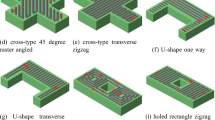Abstract
The monitoring of casting quality is very important to ensure the safe operation of casting processes. In this paper, in order to improve the accurate detection of casting defects, a combined method based on principal component analysis (PCA) and self-organizing map (SOM) is presented. The proposed method reduces the dimensionality of the original data by the projection of the data onto a smaller subspace through PCA. It uses Hotelling’s T2 and Q statistics as essential features for characterizing the process functionality. The SOM is used to improve the separation between casting defects. It computes the metric distances based similarity, using the T2 and Q (T2Q) statistics as input. A comparative study between conventional SOM, SOM with reduced data, and SOM with selected features is examined. The proposed method is used to identify the running conditions of the low pressure lost foam casting process. The monitoring results indicate that the SOM based on T2Q as feature vectors remains important comparatively to conventional SOM and SOM based on reduced data.








Similar content being viewed by others
References
Beeley P (2001) Foundry technology, 2nd edn. Butterworth-Henemann, Oxford
Rao P (2008) Manufacturing technology: foundry, forming and welding. Tata McGraw Hill
Hughes RR, Dixon S (2014) Eddy-current crack detection at frequencies approaching electrical resonance. AIP Conf Proc 1581(1):1366–1373
Kim HM, Rho YW, Yoo HR, Cho SH, Kim DK, Koo SJ, Park GS (2012) A study on the measurement of axial cracks in the magnetic flux leakage NDT system. In: IEEE International Conference on Automation Science and Engineering (CASE): 624–629
Dabade UA, Bhedasgaonkar RC (2013) Casting defect analysis using design of experiments (DoE) and computer aided casting simulation technique. Procedia CIRP 7:616–621
Zhang L, Wang R (2013) An intelligent system for low-pressure die-cast process parameters optimization. Int J Adv Manuf Technol 65:517–524
Zhao X, He Z, Zhang S, Liang D (2015) A sparse-representation-based robust inspection system for hidden defects classification in casting components. Neurocomputing 153:1–10
Sata A, Ravi B (2017) Bayesian inference-based investment-casting defect analysis system for industrial application. Int J Adv Manuf Technol 90:3301–3315
Galan U, Orta P, Kurfess T, Ahuett-Garza H (2018) Surface defect identification and measurement for metal castings by vision system. Manuf Lett 15:5–8
Lee J, Lee YC, Kim JT (2021) Migration from the traditional to the smart factory in the die-casting industry: novel process data acquisition and fault detection based on artificial neural network. J Mater Process Technol 290:116972
Niu B, Qu X, Guan X, Zhang F (2021) Rapid detection of highly reflective surface defects based on digital micromirror device. Opt Commun 501:127385
Yang Q, Jin J, Chang TS (2010) Automatic feature extraction and classification of surface defects in continuous casting. Transactions North American Manufacturing Research Institution of SME 38:563–570
Lin J, Yao Y, Ma L, Wang Y (2018) Detection of a casting defect tracked by deep convolution neural network. Int J Adv Manuf Technol 97:573–581
Ai Y, Xu K (2013) Surface detection of continuous casting slabs based on curvelet transform and kernel locality preserving projections. J Iron Steel Res Int 20(5):80–86
Yu Y, Luo X, Liu Q (2017) Model predictive control of a dynamic nonlinear PDE system with application to continuous casting. J Process Control 65:41–55
Bouhouche S, Yahi M, Bast J (2011) Combined use of principal component analysis and self-organization map for condition monitoring in pickling process. Appl Soft Comput 11:3075–3082
Bouhouche S, Laïb DLY, Bast J (2014) Evaluation-based closed-loop errors using principal component analysis and self-organisation map with an application to a pickling process. Int J Adv Manuf Technol 70:1033–1041
Bendjama H, Mahdi D (2016) Computer code for materials diagnosis using Monte Carlo method and neural networks. J Fail Anal Prev 16(4):931–937
Lang L (1999) Development and testing of a low pressure lost foam casting machine and an examination of the process. PhD thesis, Freiberg University, Germany
Bast J, Aitsuradse M, Hahn T (2004) Advantages of the low pressure lost foam casting process. AFS Transactions 112:1131–1144
Anderson TW (2003) An introduction to multivariate statistical analysis. John Wiley & Sons, California
Tamura M, Tsujita S (2007) A study on the number of principal components and sensitivity of fault detection using PCA. Comput Chem Eng 31:1035–1046
Jackson JE (2003) A user’s guide to principal components. John Wiley & Sons, New York
Kohonen T (2001) Self-organizing Maps. Springer-Verlag, Berlin
Acknowledgements
This research acknowledges the German Academic Exchange Service (in German, Deutscher Akademischer Austausch Dienst (DAAD)). The authors would like to extend their greatest gratitude to the Institute of Mechanical Engineering, Freiberg University of Mining and Technology, Freiberg, Germany. Comments and suggestions from anonymous reviewers and the Editor are greatly appreciated to improve the manuscript.
Author information
Authors and Affiliations
Corresponding author
Ethics declarations
Ethics approval
Not applicable.
Consent to participate
Not applicable.
Consent for publication
Not applicable.
Conflict of interest
The authors declare no competing interests.
Additional information
Publisher's Note
Springer Nature remains neutral with regard to jurisdictional claims in published maps and institutional affiliations.
Rights and permissions
About this article
Cite this article
Bendjama, H., Bouhouche, S., Aouabdi, S. et al. Monitoring of casting quality using principal component analysis and self-organizing map. Int J Adv Manuf Technol 120, 3599–3607 (2022). https://doi.org/10.1007/s00170-022-08993-9
Received:
Accepted:
Published:
Issue Date:
DOI: https://doi.org/10.1007/s00170-022-08993-9




